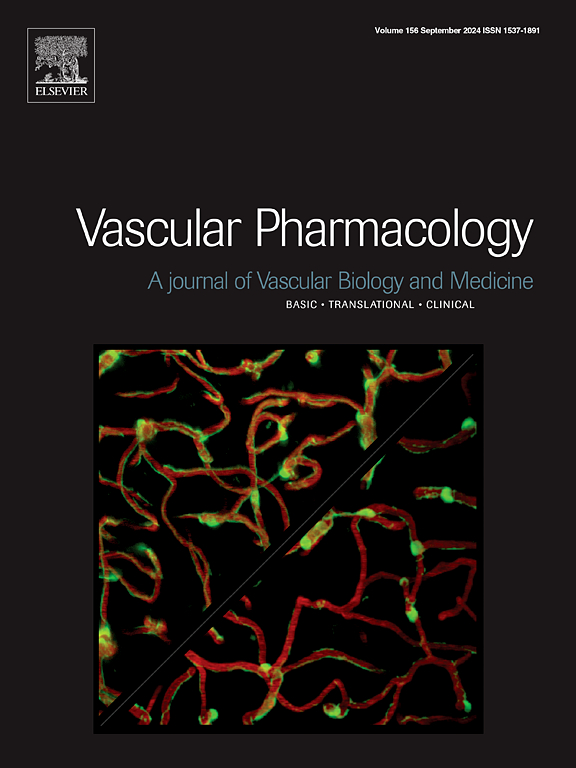血管直径决定了人肠系膜和肾动脉对可溶性鸟苷酸环化酶激活的敏感性
IF 3.5
3区 医学
Q2 PHARMACOLOGY & PHARMACY
引用次数: 0
摘要
目的研究动脉对可溶性鸟苷酸环化酶(sGC)/蛋白激酶G (PKG)途径激活的反应性是否与年龄、血管定位和直径有关,并探讨sGC激活剂诱导人动脉血管舒张的分子机制。方法硝普钠(SNP)或sGC激活剂cinaciguu刺激ssgc /PKG。用钢丝肌造影法研究了幼龄、老年小鼠以及择期结肠切除或肾切除术患者的肠系膜动脉和肾内动脉。Western blot检测肌球蛋白19丝氨酸调控20 kda轻链(MLC20-S19)和肌球蛋白磷酸酶苏氨酸853和丝氨酸668靶向亚基(MYPT1-T853和MYPT1-S668)的磷酸化。结果在小鼠血管中,SNP和辛西瓜诱导的肾内动脉血管舒张明显小于肠系膜动脉血管舒张,且无年龄依赖性。人的肾内和肠系膜动脉在SNP和cinaciguat的作用下表现出类似的血管扩张。在两个血管床,动脉的管腔直径<;700 μm的紫杉醇诱导的血管舒张作用强于管腔直径为700 μm的动脉;700μm。0.1 μmol/l的Cinaciguat增加了700 μm血管中pkg依赖性的MYPT1-S668磷酸化,但在700 μm血管中没有。Cinaciguat仅在700 μm肠系膜动脉中显著降低MLC20-S19的磷酸化。结论与小鼠动脉相比,SNP和辛西瓜诱导的人肾内动脉和肠系膜动脉血管舒张相似。在人体血管系统中,无论MLC20-S19磷酸化程度如何,小直径动脉比大直径血管对sGC激活的反应更灵敏。本文章由计算机程序翻译,如有差异,请以英文原文为准。

Vascular diameter determines sensitivity to soluble guanylate cyclase activation in human mesenteric and renal arteries
Objective
This study tested if arterial reactivity to soluble guanylate cyclase (sGC)/protein kinase G (PKG) pathway activation depends on age, vessel localization as well as diameter and investigated the molecular mechanisms involved in sGC activator-induced vasodilation in human arteries.
Methods
sGC/PKG were stimulated by sodium nitroprusside (SNP) or the sGC activator cinaciguat. Mesenteric and intrarenal arteries from young and aged mice as well as from patients who underwent elective colon resection or nephrectomy were investigated by wire myography. Phosphorylation of the regulatory 20-kDa light-chain of myosin at serine 19 (MLC20-S19) and targeting-subunit-of-myosin-phosphatase at threonine 853 and serine 668 (MYPT1-T853 and MYPT1-S668) were determined by Western blot.
Results
In murine vessels, SNP- and cinaciguat-induced vasodilation was significantly less in intrarenal than in mesenteric arteries and not age-dependent. Human intrarenal and mesenteric arteries showed a similar vasodilation in response to SNP and cinaciguat. In both vascular beds arteries with a lumen diameter < 700 μm showed a stronger cinaciguat-induced vasodilation than arteries with a lumen diameter > 700 μm. Cinaciguat (0.1 μmol/l) increased PKG-dependent MYPT1-S668 phosphorylation in <700 μm vessels but not in >700 μm vessels. Cinaciguat significantly reduced MLC20-S19 phosphorylation only in <700 μm mesenteric arteries.
Conclusions
In contrast to murine arteries, SNP- and cinaciguat-induced vasodilation is similar in human intrarenal and mesenteric arteries. In the human vasculature, small diameter arteries are more responsive to sGC activation than large diameter vessels irrespective of the degree of MLC20-S19 phosphorylation.
求助全文
通过发布文献求助,成功后即可免费获取论文全文。
去求助
来源期刊

Vascular pharmacology
医学-药学
CiteScore
6.60
自引率
2.50%
发文量
153
审稿时长
31 days
期刊介绍:
Vascular Pharmacology publishes papers, which contains results of all aspects of biology and pharmacology of the vascular system.
Papers are encouraged in basic, translational and clinical aspects of Vascular Biology and Pharmacology, utilizing approaches ranging from molecular biology to integrative physiology. All papers are in English.
The Journal publishes review articles which include vascular aspects of thrombosis, inflammation, cell signalling, atherosclerosis, and lipid metabolism.
 求助内容:
求助内容: 应助结果提醒方式:
应助结果提醒方式:


